Estimated reading time 15 minutes, 20 seconds.
As the vintage jets sit dormant on the ramp, the crew – sporting matching green flight suits – bustles between each of the machines, attending to every pre-flight detail.
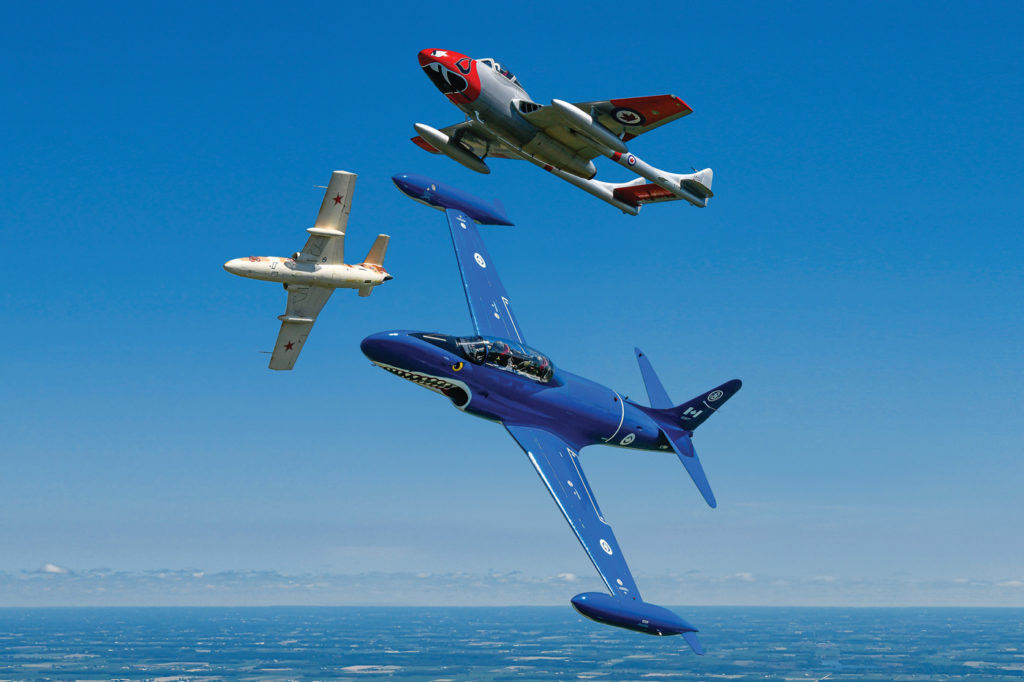
The hot sun beats down on the weathered tarmac as the historic warbirds are fuelled before flight time. Each aircraft, an historic relic with its own important footnote in the annals of aviation, is lined up in a row: the bright blue Canadair CT-133 “Mako Shark;” an unassuming Mikoyan-Gurevich MiG-15 UTI – the only one of its type flying in Canada; the oddly crafted and unique frame of the de Havilland Vampire Mk 55; and the stout Aero L-29 “Viper” Delfin in desert camo – upgraded with a Rolls-Royce Viper engine.
The ground crew carries out any last-minute checks on the aircraft. Their co-ordinator scurries to ensure everything has been taken care of, stopping for a quick word with several awestruck admirers, saying, “Gorgeous, aren’t they? Excuse me, I have to make sure everything is run completely to standard!”
Pilots, each a well-experienced aviator, wait patiently and calmly; hidden from the sun in the shadow of the towering tail of a Global Express parked for the afternoon at the Region of Waterloo International Airport (CYKF). Flight suits hang half open – in standby as they anticipate the flight to come.
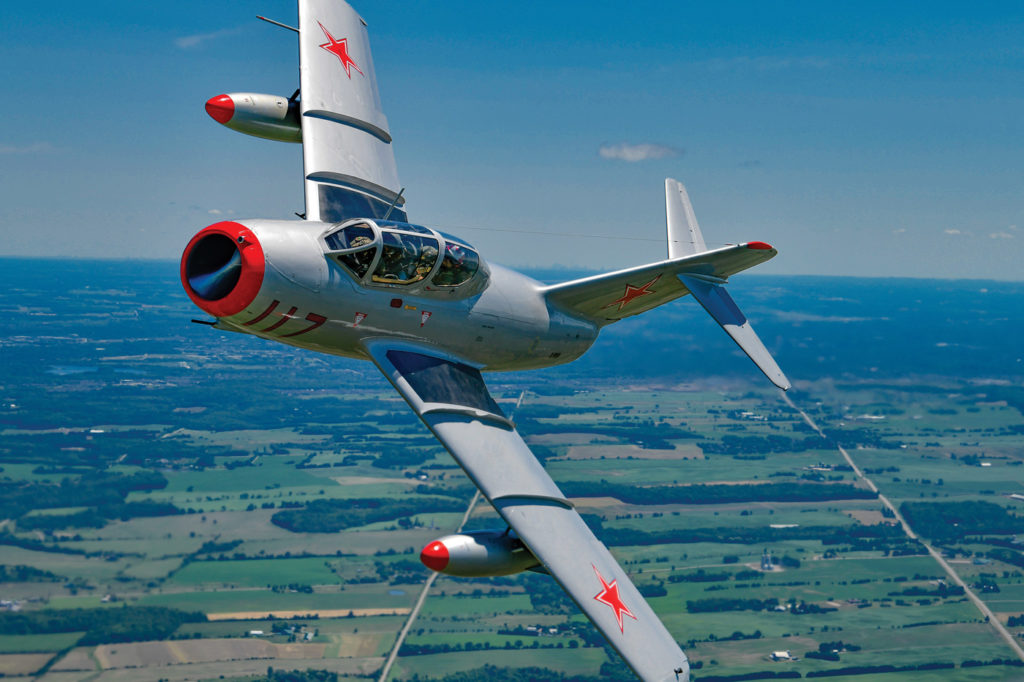
These are the Waterloo Warbirds, a volunteer team dedicated to the preservation and operation of the four well-known jets. Along with the jet aircraft, the group also owns and operates a Harvard Mk. II that assists with training pilots, and is starting restoration on a second CT-133.
The crew came together in 2014, when the owners of the four private aircraft wanted to ensure they could be seen and appreciated by the public. They chose to merge operations, focus on securing funding and continue to fly out of Waterloo – thus, the team was born.
Along with the aircraft – undoubtedly the stars of the show – the Warbirds’ diverse team includes 19 aviation enthusiasts (four pilots and 15 maintenance and office crew members) whose passion for the skies drives them to volunteer their valuable time to promote the historical jets they fly.
You may have seen them at airshows, each jet dressed to impress with an eye-catching paint scheme.
“We try to find something that’ll get kids interested in the aircraft,” said Derek Hammond, the Warbirds’ president, director of flight ops and a pilot with the team. “But it’s not just kids that the paint speaks to.”

The CT-133 snarls back at anyone who dares to shoot it a glance, baring sharp white fangs at the head of a vibrant, sky blue frame. The Vampire wears the colours of historic Royal Canadian Air Force (RCAF) 442 Squadron, which flew the jet warbird in the 1940s and early 50s – it’s a muted grey with red trim, the signature bat face adorning the nose. While the Soviet aircraft, the L-29 and MiG-15, don much simpler livery – the L-29 in a desert camo comprised of beige, brown and orange and the MiG in the traditional silver with a red nose – both wear the Soviet Union red star.
The team has made plenty of public appearances in the years since conception – they typically attend six airshows a year. Though you may recognize them from a show or static display, that’s not the only way to get up close and personal with these historic machines.
Waterloo Warbirds also offers adventure flights to any enthusiast willing to pay for the experience. Ranging from $2,000 for a ride in the L-29 to $5,500 to fly in the MiG-15, the group offers the experience of a lifetime. According to Ramona Ostrander, self-proclaimed aviation geek and the Warbirds’ team co-ordinator, the opportunity stretches beyond just the 30-minute flight time.
“We work with [guests] to build an experience that goes beyond their day with Waterloo Warbirds,” she explained. “Their half-day here starts long before they ever get to the airport, with the preparatory work that we give them beforehand to become familiar with the upcoming flight experience and the jet themselves. Then, when they get here, they will go through an entire safety briefing, both in the classroom and cockpit. Very often, [they] bring guests with them and we try to accommodate and make the experience include them as well to the best [of our ability].”
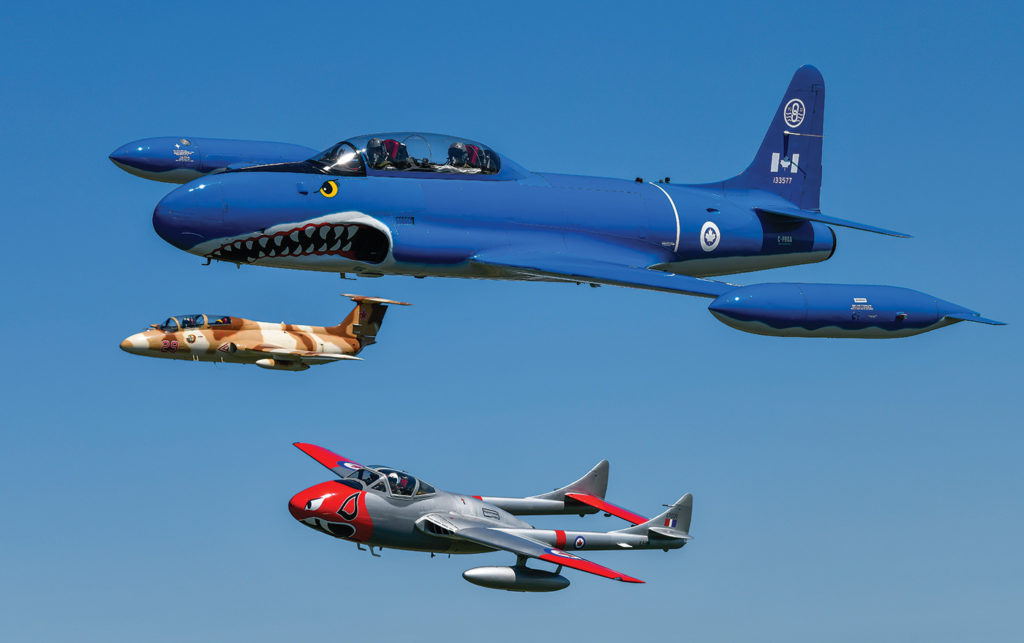
Ostrander buzzes around the tarmac, making sure everything and everybody is in place, doing what they must to ensure the flights go as smoothly and safely as possible. Her team is attentive and painstakingly combs over every detail.
While the idea of flying old jet warbirds is enthralling to any aviation enthusiast, there is a ton of work that goes into making sure the team’s operations and aircraft are up to Transport Canada standards.
“There’s always challenges working with the regulatory body,” explained Hammond. “But we do find because we try to operate the aircraft at a very high professional level that Transport Canada is forthcoming. You have to remember, a lot of the inspectors that we deal with know these are warbirds — they’re in aviation; it’s a passion for them, too.”
That passion can be found in abundance at the Waterloo airport, the Warbirds’ home base. Hangared with Flite Line Services, the team strictly adheres to regulatory standards for importing and maintaining its aircraft.
On a hot July day when the Skies team arrived to fly with Waterloo Warbirds, the pilots waited earnestly, welcoming the chance to volunteer their time for a formation flight photo shoot.
Vampire pilot Peter Stewart stared into the eyes of the bat on the nose of the jet. “It’s just a really special experience,” he said.
“It’s really fast; I’ve never been in anything that we can cruise at 300 knots in . . . I’m used to closing the throttle on the airplane and it slows down. This one just keeps on going.”
Maintaining History
The aircraft in the collection come from far and wide. Each member of the fleet is an established flyer with an interesting history.
From both sides of the Iron Curtain, these jets have operated in crucial training roles for their respective air forces — Canadian, Swiss, Polish and Czechoslovakian. The diversity of the aircraft has made the Warbirds’ fleet the most unique jet fleet in Canada, popular not only among domestic enthusiasts, but globally as well.
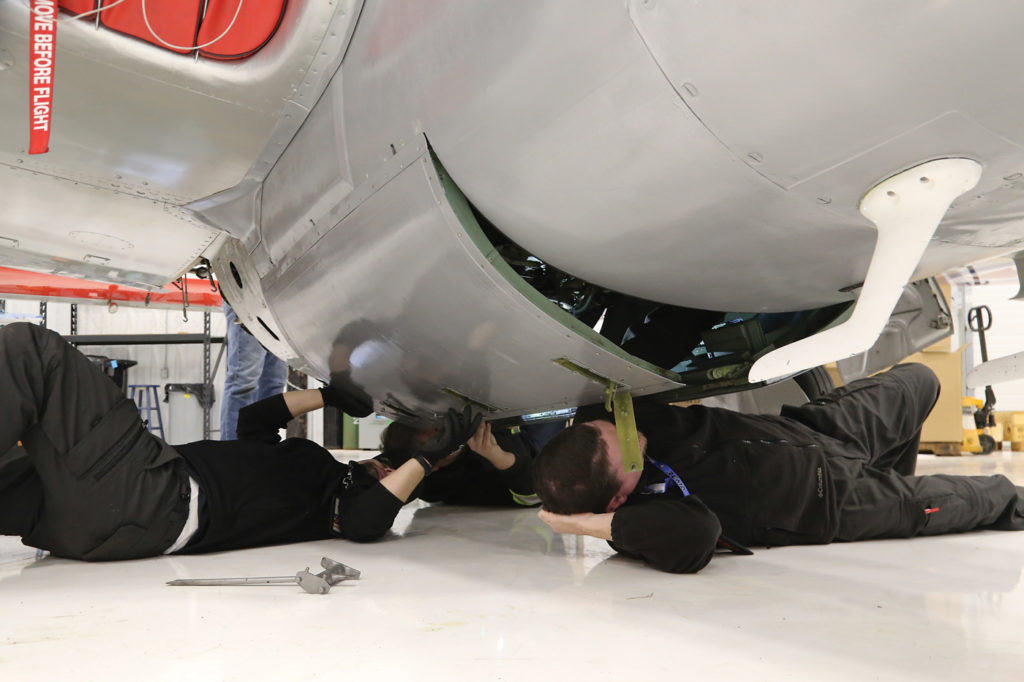
“We accommodate over 80 per cent of our flight experiences for international individuals, joining us from around the world,” said Ostrander. “Predominantly Europe and Asia but we’ve even had people here from New Zealand … It’s something that’s gained quite a word-of-mouth [reputation] across the world as a go-to jet flight provider. And, it reflects the professionalism of this team and the quality of our flight experiences to be able to say we are truly a globally known organization.”
Don’t be fooled into thinking their mission is easy – the diversity of the fleet requires a meticulous maintenance program. Tucked away in the back corner of the airport property is the large, faded-blue Hangar 51. There, Flite Line Services’ director of maintenance, Andrej Janik, and his team have had to get creative while pursuing their mission to keep the aircraft operational and safe. In doing so, the team tasked with preserving the jets has learned that finding parts to service them – particularly the Soviet aircraft – can present its own unique set of challenges.
“[With] the Russian-built airplane parts, we depend on the owner-operator and their contacts of other owner-operators,” explained Janik. “A lot of the stuff we’re getting into now we have to remanufacture. So, we basically reverse engineer a component that we’re looking for and we have to build it ourselves.”
But these hurdles haven’t hampered the serviceability of the aircraft, even when a project requires the team to completely re-design and install a 65-year-old MiG-15’s braking system.

“The owner was concerned with the braking performance [of the MiG],” said Janik. “Because there were no more parts available and the design of it was basically for long Russian runways . . . he wanted to be able to stop within a 5,000-foot runway.”
It was an understandable concern, especially when the owner in question, Richard Cooper, emphasized the jet’s inherent need for speed.
“It likes to go fast. It doesn’t like going very slow; once you start to slow the aircraft down too much, you start to get into a wing rocking motion that’s an early warning that it’s going to roll over on you if you’re not careful,” said Cooper. “On approach you’re coming in at 135 knots, which is a pretty quick speed considering the aircraft was originally designed with drum brakes and doesn’t stop on a dime.”
The solution was rudimentary but far from easy to accomplish — take the design of the CT-133 hydraulic braking system, which has a similar wheel-size to the MiG, and mould it to work on the Soviet aircraft.
“Originally the MiG-15’s got an air brake system, so we basically had to redesign the whole braking system from the cockpit pedals all the way down to the wheels,” recounted Janik. “Every single component in the system we had to redesign from an air brake system to a hydraulic system. That took about a year of scratching our heads and trying different things, but eventually we came up with modified brake pedals with master cylinders.”
The Soviet jets aren’t the only ones that can prove to be a handful. The Vampire, as the first jet fighter flown by the RCAF, shows its age in its design.

“Someone once described the Vampire cockpit as if they put glue on instruments, put them on a shovel and just threw them [at the panel],” joked Hammond.
With its combined wood and metal frame, the Vampire has forced Janik and his crew to diversify their skill set, needing to know “everything you can think of in a maintenance technician’s training handbook. We basically touch everything in that book . . . You require a large and varied skill set to work on these aircraft and most of us get it from just working on the aircraft and on-the-job training.”
Experience of a lifetime
The results of the team’s efforts are widespread. Not only do they provide their pilots with safe jets to fly, they also provide the public with a chance to experience history.
Airshows allow enthusiasts to get up close and personal with aircraft they may have only ever read about. The chance to fly with Waterloo Warbirds offers once-in-a-lifetime opportunities for certain fans — while allowing others the chance to relive the past.
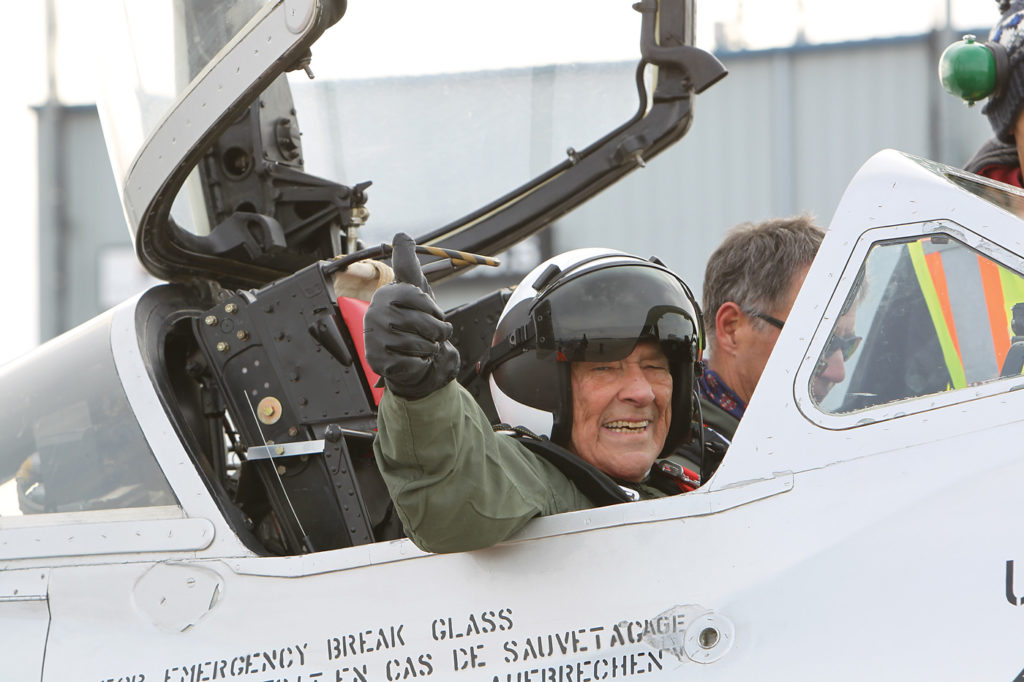
“We actually had quite a few people that have flown in the air force and then returned this year,” said Hammond. “We had a U.S. Air Force veteran that flew them [CT-133] back in the 50s . . . we get quite a few veterans from the Canadian Air Force that flew them in the 50s and 60s. It’s also kind of humbling when you’ve got a guy that’s got thousands of hours in the aircraft and you’re sitting there briefing them about the back seat. Most of them have much more flying experience in the aircraft than you.”
Ostrander relishes the fact that Waterloo Warbirds offers those who have previously flown the aircraft the opportunity to experience it again.
“It’s very cherished time when you get to be able to sit with an individual who is able to share those stories, and willing to share those stories, and gives you an insight into what it was like for them in the cockpits,” said the team co-ordinator. “That’s one thing that I would say translates very well, hearing it from the mouths of those who truly flew them as they were supposed to be flown, to the experiences we give passengers. Being able to transfer that experience and story from one to the other deepens the experience for both.”
But the door isn’t only open to veterans; the half-day opportunity is offered to any fan curious to feel what flight in a vintage jet feels like — but it doesn’t begin and end there.
The experience opens with a thorough briefing and walkthrough of the flight; passengers are put through intense training both in the classroom and cockpit.
Safety is paramount in all operations. Even on a day without paying passengers, when Skies visited for the air-to-air photo shoot, the pilots provided a complete briefing of the flight to come.
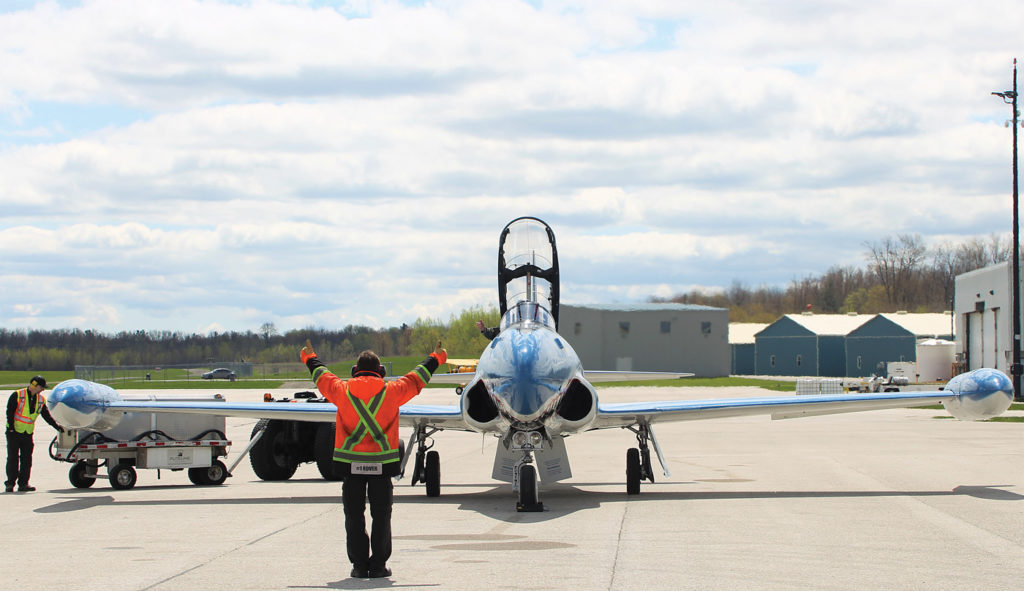
Dave Hewitt, owner and operator of the ex-RCAF Beech 18 Expeditor tasked with serving as the photo ship that day, reminded the other pilots how crucial it was to fly by the book during the routine.
“You only get one shot at this, so make it a honey,” he said.
Show time
The low whistle of the Rolls-Royce Nene 10 turbojet engine begins to pierce the air as the CT-133 slowly awakens. It is followed by the Vampire and the L-29, while the MiG will have to wait at least 20 minutes before taxiing out. Its speed is far too brisk to take off alongside the others.
The time to fly has finally arrived. After a long, engaging day of admiring the aircraft before heading into the briefing room, the moment is here and excitement abounds.
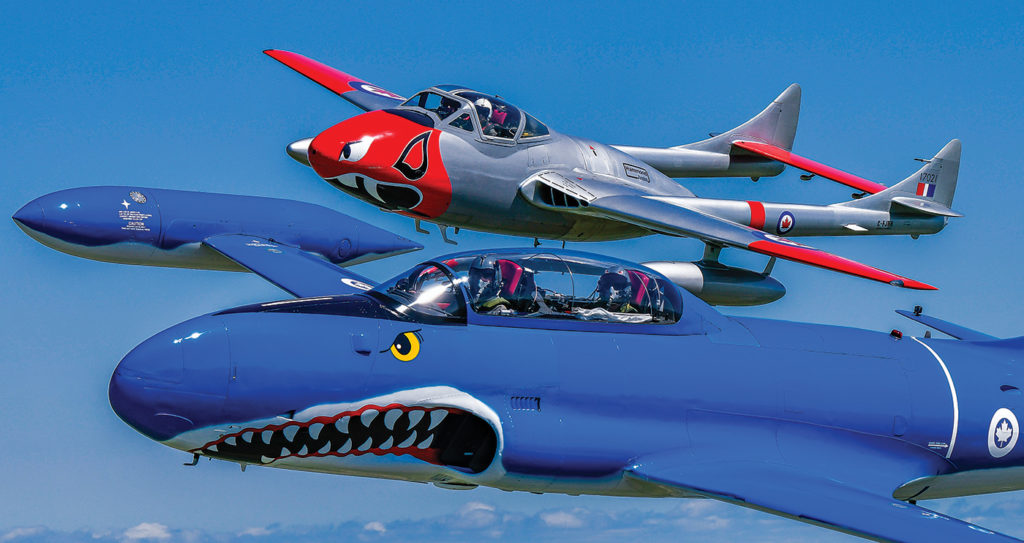
The CT-133, Vampire and L-29 Viper taxi, in formation, to the far end of the runway — and then they take off together, one shortly after the other.
It’s a beautiful demonstration. The engine noise escalates in a fraction of a second — from a near standstill they accelerate down the runway, the power of the jets immediately apparent. They take off cleanly into the vast, blue Ontario skies, and those of us on the ground are left to wonder just how it would feel to be right there with them.

